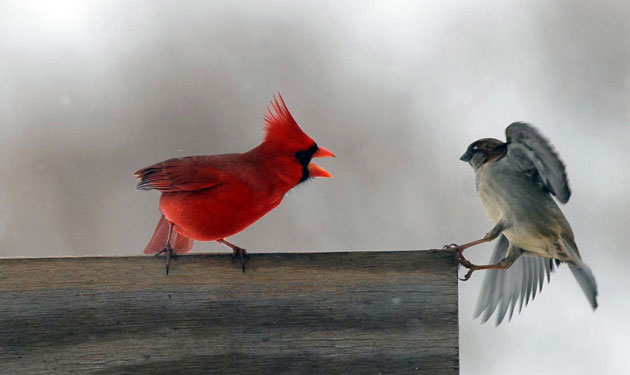TOP STORIES
Florida Sea Turtle Cold-Stunning – News Update Report from NOAA/NMFS Florida has been experiencing unusually cold temperatures since early January, which has caused a massive cold-stunning event of endangered and threatened sea turtles. The Florida Fish and Wildlife Conservation Commission (FWC) is leading the response effort, with assistance from NOAA, the U.S. Fish and Wildlife Service, NASA Kennedy Space Center, National Park Service, U.S. Coast Guard, Florida aquaria, and many volunteers.
Florida has been experiencing unusually cold temperatures since early January, which has caused a massive cold-stunning event of endangered and threatened sea turtles. The Florida Fish and Wildlife Conservation Commission (FWC) is leading the response effort, with assistance from NOAA, the U.S. Fish and Wildlife Service, NASA Kennedy Space Center, National Park Service, U.S. Coast Guard, Florida aquaria, and many volunteers.
Since January 6, approximately 3500 sea turtles have been recovered, primarily split between two areas 1) the Cape Canaveral area, including the southern end of Mosquito Lagoon, northern end of the Banana River and the Indian River Lagoon in Brevard County, and 2) St. Joseph Bay, between Apalachicola and Panama City, in Gulf County.
14 January 2010
S McNulty
Photo courtesy of J Hill (FWC)
FWP kills 7 sheep with pneumona
State wildlife officials have killed seven bighorn sheep as they try to limit an outbreak of pneumonia in a herd in the mountains west of the Marshall Ski Area.
Two ewes killed on Tuesday and three more killed on Wednesday all tested positive for pneumonia at the Fish, Wildlife and Park's wildlife lab in Bozeman.
14 January 2010
Location: Missoula, Montana, USA - Map It

Polar Bear Droppings Advance Superbug Debate

Scientists investigating the spread of antibiotic-resistant superbugs have gone the extra mile for their research -- all the way to the Arctic.
Researchers writing in the open access journal BMC Microbiology found little sign of the microbes in the droppings of polar bears that have had limited or no contact with humans, suggesting that the spread of antibiotic resistance genes seen in other animals may be the result of human influence.
13 January 2010
Photo courtesy of BBC Earth News
More Polar Bear News
Reported Wildlife Mortality Events to the USGS National Wildlife Health Center Updated
USGS National Wildlife Health Center
14 January 2010
Area: United States
USGS and a network of partners across the country work on documenting wildlife mortality events in order to provide timely and accurate information on locations, species and causes of death. This information was updated on January 14, 2010 on the USGS National Wildlife Health Center web page, New and Ongoing Wildlife Mortality Events Nationwide. Quarterly Mortality Reports are also available from this page. These reports go back to 1995.
TOP READ LINKS FROM LAST WEEK
News
- Camera traps yield first-time film of tigress and cubs [includes video 1 min, 12 sec]
- Killer bat disease on the move
- Solar project vs. Wildlife
- Arctic bird makes rare appearance
- Behind Mass Die-Offs,Pesticides Lurk as Culprit Publications
- Official: Dolphins, pelicans found dead
- A model for wildlife-friendly energy development
- Using cave gates to protect endangered bats [video]
- Influenza and wildlife: Mix and match
- Birds fight alien parasites: Darwin's finches develop antibodies to flies, pox virus
- For warmth, manatees congregate in canal
- White-Nose Syndrome Fungus (Geomyces destructans) in Bat, France [free full-text pdf available]
- Avian Diseases [Issue December 2009]
- Metals in Feathers of Black-Crowned Night-Heron (Nycticorax nycticorax) Chicks from the New York Harbor Estuary
- Annual Variation in West Nile Virus Antibodies in American Kestrels (Falco sparverius) in Eastern Pennsylvania
OTHER WILDLIFE HEALTH RELATED NEWS
Photo credit: T Prather/AP
- The week in wildlife [image gallery]

- Asian Partnership on Emerging Infectious Diseases Research (APEIR) The 5th APEIR Regional Meeting [see first "Key Outcome" for avian influenza in migratory birds]
- ‘Sparse’ bird population noted [Pinawa and Lac du Bonnet, Manitoba, Canada]
- New System Helps Explain Salmon Migration
White-Nose Syndrome
- Disease epidemic killing only US bats
- Why mass die-off of bats should be of grave concern [includes video, 4:46]
It Ain't All Bad News
- 'World's Least Known Bird' Discovered Breeding in Afghanistan [cited journal article]
- Ultralight-led whooping cranes arrive in Florida
- Feds develop plan to fight marine debris in Hawaii [Hawaii Marine Debris Action Plan]
Huh, That's Interesting!
- Light shed on fish gill mystery
- Birds spotted in the big freeze [photo gallery, related story here]
- Puffins' winter odyssey revealed




